
http://www.iaeme.com/IJM/index.asp 95 editor@iaeme.com
International Journal of Management (IJM)
Volume 7, Issue 6, September–October 2016, pp.95–110, Article ID: IJM_07_06_011
Available online at
http://www.iaeme.com/ijm/issues.asp?JType=IJM&VType=7&IType=6
Journal Impact Factor (2016): 8.1920 (Calculated by GISI) www.jifactor.com
ISSN Print: 0976-6502 and ISSN Online: 0976-6510
© IAEME Publication
FACTORS INFLUENCING THE PERFORMANCE
APPRAISAL SYSTEM AMONG WOMEN AND MEN: A
COMPARATIVE ANALYSIS USING MULTINOMIAL
LOGISTIC REGRESSION APPROACH
KDV Prasad
Faculty of Commerce, Rashtrasant Tukdoji Maharaj Nagpur University, Nagpur, India.
Rajesh Vaidya
Assistant Professor, Department of Management and Technology,
Shree Ramdeobaba College of Engineering and Management, Nagpur, India.
ABSTRACT
In our research outcome we presented the results of a comparative analysis among men and
women on the employee factors influencing the evaluation performance appraisal system using
Multinomial Regression Analysis with reference to Agriculture Research Sector employees in
Hyderabad Metro, India. The primary data collected from the performance appraisal forms of 400
employees including 300 Men and 100 Women, working in the agriculture research institutes in and
around Hyderabad. The seven independent factors Job Knowledge, Skill Level, Job Execution,
Initiative, Client Orientation, Team Work, Compliance to Policies and Practices, and one dependent
factor, the final outcome of the Performance Appraisal System the Rating measured. The descriptive
analysis, and Multinomial Logistic Regression analysis carried out to arrive at the conclusions. To
measure the reliability of the instrument used for this study and internal consistencies the reliability
statistics Cronbach’s alpha (C-Alpha) was estimated. The overall C-Alpha value for men measured
at 0.91 and 0.94 for women, and the C-Alpha values for all the factors ranged 0.84 to 0.85 for men
and 0.79 to 0.90 for women. The overall Spearman Brown Split-half reliability measured at 0.88
and 0.86 for men and women respectively. The multinomial logistic regression analysis was
performed to estimate the likelyhood odds ratios (ORs) to explain the factors associated outcome of
the performance appraisal system Rating, a dependent variable. It can be observed from the relative
log odds ratios of Women that significant negative influence of all the independent variables, except
Client Orientation at 95% CI level for the dependent variable Rating outcome Good and Excellent
versus Outstanding. In case of Men all the independent factors negatively contributing for this model
for performance appraisal outcome Rating Good, Excellent vs Outstanding. This was explained in
detail in the Results section of the paper.
Key words: Multinomial Logistic Regression, C-Alpha; Tem Work, Performance Appraisal,
Policies, Reliability.

KDV Prasad and Rajesh Vaidya
http://www.iaeme.com/IJM/index.asp 96 editor@iaeme.com
Cite this Article: KDV Prasad and Rajesh Vaidya, Factors Influencing the Performance Appraisal
System among Women and Men: A Comparative Analysis using Multinomial Logistic Regression
Approach. International Journal of Management, 7(6), 2016, pp. 95–110.
http://www.iaeme.com/IJM/issues.asp?JType=IJM&VType=7&IType=6
1. INTRODUCTION
Performance appraisal (PA) is a formal system of review and evaluation of an individual or performance and
peers will be reviewing an individual’s performance on a continuing basis. The Performance Appraisal
System (PAS) a development tool used to measure the actual performance in an organization and the strategic
goals of the organization are aligned to that of individual performance. Using Performance Appraisal System
an employee’s performance is measured against core competencies such as Job knowledge, Skill level, Job
execution, Initiative, Client orientation, Cooperation and ability work effectively, Quality and quantity of
output, Leadership qualities, and Compliance to policies and practices including safety and environment,
Efficient handling of available resources, Intuitiveness to take new assignments and learn new things, etc.
However the core competencies will vary from organization to organizations depending on its objectives,
business strategies, and mission.
The performance management is an extensive, methodical, sequential and continuous process that
involves performance mapping processes and sequences (Garvin 1998). Organizations that emphasize
accountability tend to use performance targets, but too much emphasis on "hard" targets can potentially have
dysfunctional consequences. In general most of the organizations include the performance appraisal system
under Performance Management system on yearly basis, where supervisor/subordinate interview with a
standard performance appraisal form with the factors to be appraised or listed in the form (Dargam 2009).
The performance management provides more opportunities for individuals to discuss their work with their
managers in an attractive atmosphere (Armstrong, 1991). Performance Appraisal system is a continuous
process and a natural aspect of management and assess performance by reference to agreed objectives.
Performance management gives direction to the employees through guidance from management (Medlin
2013). Managing organisations is about managing performance of people who work in organisations. The
human resources managers believe that PAS is a good tool for performance improvement Longenecker and
Goff (1992), if well designed and implemented it can benefit both the employees and the organizations
(Coens and Jenkins, 2000). DeNisis and Pritchard (2006) aver that attitudes toward performance
management affect the performance of employees in organisations.
1.1. Importance of Performance Appraisal in Agricultural Research Sector
The main objective of PAS in Agricultural Research Center is to improve employee and increase the potential
of a researcher in performance. Though the PAS can cause some dissatisfaction over how the employee as
appraised, still it can help to achieve organization’s vision and mission. PAS one of the human resources
valuable functional area which is helpful in correcting the deviations/errors in employee performance.
At the Agricultural Research Sector PAS being effectively used for Human Resource Planning In
assessing a list of staff to be promoted, to identify the underperformed employees who need a corrective
action. PAS also a useful tool for succession planning and provides a profile for the agricultural research
sector organizations strengths and weakness. The PAS evaluations ratings will be used for Recruitment and
Selection at the next level. The ratings will provide a benchmarks for evaluating internal applicant responses
obtained through interviews. The PAS will be used to identify the Training and Development needs of the
sector by identifying the employee deficiencies in those core competencies that effect the outcome of the
performance. The PAS system is helpful for career planning, compensation program, succession planning
and human resources development.

Factors Influencing the Performance Appraisal System among Women and Men: A Comparative Analysis using
Multinomial Logistic Regression Approach
http://www.iaeme.com/IJM/index.asp 97 editor@iaeme.com
2. REVIEW OF LITERATURE
Performance appraisal is an unpleasant management practice. With so much controversy in it, appraisal is
continually used in the public sector around the world as an instrument to oversee the performance of its
personnel (Vallance, 1999). Researchers suggested to have an effective human resource system for
organizations the use of an appraisal system which is reliable and accurate for employee assessment and
organisational development (Armstrong, 2003; Bohlander & Snell, 2004; Desler, 2008).
George Ndemo Ochoti et al. (2012) studied the Factors Influencing Employee Performance Appraisal
System: A Case of the Ministry of State for Provincial Administration & Internal Security, Kenya.
Performance Appraisal system is a good tool for human resource management and performance
improvement (Longenecker and Goff, 1992). Involving the employees to understand organizational goals,
what is expected of them and what they will expect for achieving their performance goal will help in
organizational development (Bertone et al. 1998). PAS should also link individual performance with reward
management (Townley, 1999). Linking performance with reward increases the levels of performances and
should be used in both public and private sectors (Armstrong & Brown, 2005).
Feedback is an important factor of PAS and the rates should be given feedback on their competence and
overall progress (Longenecker 1997). The 360 degree feedback method can be utilized by organizations as
this method combines evaluations from various sources into over all appraisal (Garavan et al. 1997).
Performance ratings are based on rater evaluations which are subject to human judgements and biasedness.
Personal factors and prejudices are like to influence ratings (Cleveland and Murphy, 1992). The interpersonal
factors are important to the PAS as they influence the outcome of the interactions (Greenberg (1993). The
employee attitude toward the system is strongly linked to satisfaction with the system. The perceptions of
fairness of the system are an important aspect that contributes to its effectiveness (Boswell and Boudreau,
2000). Understanding the employee’s attitude and behaviour about the PAS in organizations is important as
they are key to determine the effectiveness (McDawall & Fletcher, 2004). Zakaria et al. (2012) reported that
(HRM practices can develop the performance of an organisation by contributing to employee satisfaction.
The performance appraisal is arguably one of the more critical factor in terms of organisation performance
and appears to be an indispensable part of any HRM system when compared among the HR practices studied
(Shrivastava & Purang, 2011).
Yee and Chen 2009 applied fuzzy set theory in the multi-criteria performance appraisal system and
developed a performance appraisal system utilizing the performance appraisal criteria from an Information
and Communication Technology based company in Malaysia. This system uses multifactorial evaluation
model in assisting high-level management and following a systemic approach for assessing the employee
performance.
2.1. Logistic Regression
The natural logarithm logit of an odds ratio is the main mathematical concept that underlies logistic
regression. The logistic regression used for testing hypothesis about a relationship between categorical
outcome variable and one more categorical or continuous predictor variables (Peng et al. 2002). In linear
and multiple regression models sometimes the ordinary scatterplots are curved at the end with S-Shape and
is difficult to interpret because the extremes do not follow the linear trend and errors are neither normally
distributed nor constant across entire range of data (Peng, Manz, & Keck, 2001). A researcher can overcome
this problem from logistic regression applying logit transformation to the dependent variable. In the essence
logistic model predicts the logit, the natural algorithm of response variable (dependent) over continuous
variable (independent). The simple form of logistic regression adopted from (Peng et al. 2002) is:
Logit(Y) = naturallog(odds) = ln
= α + ßX
Where ß is the regression coefficient; π = Probability(Y=outcome of interest|X=x and α is the Y intercept
and this can be extended to the multiple predictors the equation is:

KDV Prasad and Rajesh Vaidya
http://www.iaeme.com/IJM/index.asp 98 editor@iaeme.com
Logit(Y) = naturallog(odds) = ln
= α + ß
1
X
1
+ ß
2
X
2+
+ ß
3
X
3+
+ ….
Where ßs are regression coefficients, Xs are set of predictors. The αs and ßs are typically estimated by
the Maximum Likelyhood (ML) method which is preferred over the weighed least squares method
(Haberman, 1978 Schlesselman, 1982)
2.2. Multinomial Logistic Regression
The multinomial logistic regression is an extension of simple logistic regression that generalized to multi
class problems such as with more than two possible discrete outcomes. Using this model one can predict the
probabilities of the different possible outcomes of a categorically distributed dependent variable or response
variable and a set of independent variables which may be continuous, binary or categorical. Using
multinomial regression the dependent variable in question is a nominal where more there are more than two
categories (Suryanwanshi et al. 2015). The nominal outcome variables using multinomial logistic regression
are modelled in which the log odds of the outcomes are modelled as linear combination of the predictor
variables (Suryanwanshi et al. 2015). Sudhir Chandra Das (2016) in his study reported the results on
predictors of work-family conflict and employee engagement among employees in Indian Insurance
Companies applying multinomial logistic regression analysis. Several researchers (Suryavanshi et al. 2015;
Sateeshkumar and Madhu, 2012; Stephen, 2014; Masoud Lotfizadeh 2014) reported their results on
occupation stress and associated factors using multinomial logistic regression. However the authors not come
across any literature using multinomial regression in PAS and attempted to use multinomial logistic
regression method for evaluating the factors of PAS using agricultural sector data.
3. OBJECTIVES OF THE STUDY AND HYPOTHESES
The objective of the study is to present the main factors influence the PAS system in the agriculture sector
institute employees;
• To identify the factors that influence PAS at the workplace of Agriculture Research Sector employee
• To identify whether there are any significant mean differences in the above said factors in influencing the PAS
among men and women
3.1. Research question
• Does there were any differences in the factors that influence the Performance Appraisal System
• Does the seven independent factors Job knowledge, Skill level, Job execution, Initiative, Client Orientation,
Team Work, Compliance to Policies and Practices one dependent factor differ significantly among men and
women on the outcome of PAS Rating?
3.2. Hypotheses
Based on the identified problem, research question and the objectives the following hypotheses were formed:
• H
0
: There are no significant differences among factors that influence the PAS
• H
A
: There are significant differences among the factors that influence the PAS
• H
1
: There are no significant differences among factors among the Men and Women that influence the PAS
• H
1A
: There are significant differences among the factors among the Men and Women that influence the PAS
4. RESEARCH METHODOLOGY
4.1. Conceptual Framework
The proposed framework was adopted based on the past research by George Ndemo Ochoti et. al. (2012).
The factors under the study have been represented diagrammatically to show the relationship between
independent factors and dependent factors (Figure 1).

Factors Influencing the Performance Appraisal System among Women and Men: A Comparative Analysis using
Multinomial Logistic Regression Approach
http://www.iaeme.com/IJM/index.asp 99 editor@iaeme.com
Figure 1 Conceptual Framework
4.2. Data Collection
Gender Frequency Percent
Men 300 75
Age:
20-29
30-34
35-39
>40
73
92
64
71
25
30
22
23
Women 100 25
Age:
20-29
30-34
35-39
>40
25
28
24
23
25
28
24
23
Total 400 100
Source: Primary data
Table 1 Demography of the research Sample
4.3. Research Instrument
The research instrument used for the survey is a standardized, structured undisguised performance appraisal
form a main source for the primary data collection. Secondary data was collected from various published
books, websites and records pertaining to the topic. The form was divided into 2 sections. In the Section I,
background information/personal such as employee name, designation, institute/organization, program, date
of joining and other details of the employee were readily available (pre-filled). The Section II of the form,
the appraisal section where seven core competencies – the factors Job knowledge, Skill level, Job execution,
Initiative, Client Orientation, Team Work, Compliance to Policies and Practices one dependent factor
Independent Factors
Job knowledge
Skill level,
Job execution
Initiative
Client Orientation
Team Work
Compliance to Policies
and Practices
Dependent Factor
Final Rating of
Performance Appraisal
System

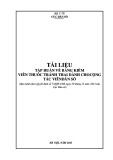
![Tài liệu tập huấn bảng kiểm viên thuốc tránh thai cho giảng viên tuyến tỉnh [Mới nhất]](https://cdn.tailieu.vn/images/document/thumbnail/2025/20250422/gaupanda088/135x160/3731745286813.jpg)
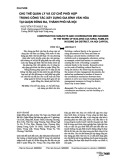

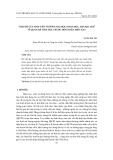
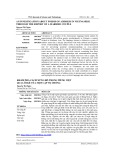
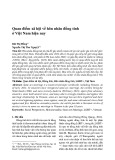

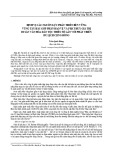
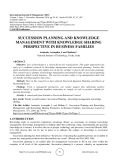


![Sổ tay Hướng dẫn truyền thông về lao động trẻ em [Mới nhất]](https://cdn.tailieu.vn/images/document/thumbnail/2025/20251114/kimphuong1001/135x160/7201763091001.jpg)







![Cẩm nang Thanh niên hành động [Mới nhất]](https://cdn.tailieu.vn/images/document/thumbnail/2025/20251017/kimphuong1001/135x160/1521760665202.jpg)




